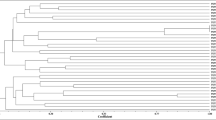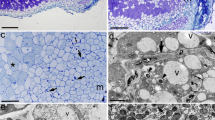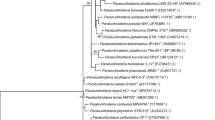Abstract
Ononis repens is a legume of the Fabaceae family with great ecological and medicinal importance that grows wild in the Maamora cork oak forest (Rabat, Morocco). The aim of this work was to analyze the diversity, phylogeny, and plant growth-promoting features of the plant root nodules microsymbionts. Out of twenty nodC-containing rhizobial bacteria, four strains, ORM6, ORM8.1, ORM 13.1, and ORM16, were selected for further molecular and phenotypic analyses. All four strains were able to metabolize a wide range of carbohydrates and amino acids as sole carbon and nitrogen sources, respectively, and grew in the presence of different pH, NaCl, and temperature conditions. They also solubilized inorganic phosphate and produced siderophores, and ORM16 was the only strain to produce indol acetic acid. The rrs gene sequence analysis showed that the four strains are members of the Mesorhizobium genus. The individual and concatenated sequences of the recA, glnII, and gyrB housekeeping genes revealed that the strains ORM6 and ORM 13.1 clustered with M. jarvisii ATCC 33,669T and M. intechii BD68 T, with which they share 93.3 and 93.7% similarity, respectively; that the strain ORM8.1 affiliated with a group of which the strain M. shonense AC39aT was the closest relative species with 84.3% similarity; and that the strain ORM16 clustered with M. australicum LMG24608T, with 80.5% similarity. These results suggest that the four O. repens-isolated strains could belong to three putative new genospecies. All four strains nodulated their original host as well as Astragalus gombiformis and A. armatus, but only the strain ORM16 was able to form nodules on Vachellia gummifera. Analysis of the symbiotic nodC gene phylogenies showed that the strains ORM6, ORM8.1, ORM 13.1, and ORM16 formed a group apart from the known symbiovars in the genus Mesorhizobium, for which the name maamori is proposed.



Similar content being viewed by others
Data Availability
All the sequences described in this work are deposited in the Genbank depository of the National Center for Biotechnology Information (NCBI).
References
Aafi A, El Kadmiri AA, Benabid B, Rochdi M (2005) Richesse et diversité floristique de la suberaie de la Mamora (Maroc). Acta Bot Malacit 30:127–138
Abdelguerfi A, Abdelguerfi-Laouar M (2004) Les ressources génétiques d’intérêt fourrager et/ou pastoral: Diversité, collecte et valorisation au niveau méditerranéen. Cah Opt Méd 62:29–41
Abdel-Kader MS (2001) Phenolic constituents of Ononis vaginalis roots. Planta Med 67:388–390
Agulló JC, Juan A, Alonso M, Terrones A, Crespo MB (2013) Taxonomic status of Ononis tridentata (Fabaceae) from Morocco, resolved by multivariate morphometric analyses. Plant Biosystems 147:645–653. https://doi.org/10.1080/11263504.2013.776650
Alami S, Lamin H, Bennis M, Bouhnik O, Lamrabet M, El Hachimi ML, Abdelmoumen H, Bedmar EJ, El Idrissi M M (2021) Characterization of Retama sphaerocarpa microsymbionts in Zaida lead mine tailings in the moroccan middle Atlas. Syst appl microbiol 44(3):126207
Al-Bakri AG, Afifi FU (2007) Evaluation of antimicrobial activity of selected plant extracts by rapid XTT colorimetry and bacterial enumeration. J Microbiol Meth 68:19–25
Al-Qudah AM, Al-Ghoul AM, Trawenh IB, Al-Jaber H, Al Shboul TM, Abu Zarga MH, Abuorabi ST (2014) Antioxidant activity and chemical composition of essential oils from jordanian Ononis natrix L. and Ononis sicula Guss. TBAP 4:52–61
Al-Snafi AE (2020) The traditional uses, constituents and pharmacological effects of Ononis spinosa. IOSR J Pharm 10(2):53–59
Altanlar N, Saltan Çitoğlu GB, Yilmaz S (2006) Antilisterial activity of some plants used in folk medicine. Pharm Biol 44:91–94
Andrews M, Andrews ME (2017) Specificity in legume-rhizobia symbioses. Int j mol sci 18(4):705
Azani N, Babineau M, Bailey CD, Banks H, Barbosa AR, Pinto RB et al (2017) A new subfamily classification of the Leguminosae based on a taxonomically comprehensive phylogeny: the Legume phylogeny Working Group (LPWG). Taxon 66(1):44–77
Bagaram BM, Mounir F, Lahssini S, Ponette Q (2016) Site suitability analysis for cork oak regeneration using GIS based multi-criteria evaluation techniques in Maamora forest-Morocco. OA Lib J 3(03):1
Bakhoum N, Galiana A, Le Roux C, Kane A, Duponnois R, Ndoye F, Fall D, Noba K, Sylla S, Diouf D (2015) Phylogeny of nodulation genes and symbiotic diversity of Acacia senegal (L.) Willd. and A. seyal (Del.) Mesorhizobium strains from different regions of Senegal. Microb Ecol 69(3):641–651
Bennis M, Perez-Tapia V, Alami S, Bouhnik O, Lamin H, Abdelmoumen H, Bedmar EJ, El Idrissi MM (2022) Characterization of plant growth-promoting bacteria isolated from the rhizosphere of Robinia pseudoacacia growing in metal-contaminated mine tailings in eastern Morocco. J Environ Manage 304:114321
Beringer JE (1974) R factor transfer in Rhizobium leguminosarum. Microbiol 84(1):188–198. https://doi.org/10.1099/00221287-84-1-188
Beukes CW, Boshoff FS, Phalane FL, Hassen AI, Le Roux MM, Stȩpkowski T, Venter SN, Steenkamp ET (2019) Both alpha and beta-rhizobia occupy the root nodules of Vachellia karroo in South Africa. Front microbiol 10:1195
Bouhnik O, Alami S, Lamin H, Lamrabet M, Bennis M, Ouajdi M, Bellaka M, Antari S, Abbas Y, Abdelmoumen H, Bedmar EJ, El Missbah M (2021) The Fodder Legume Chamaecytisus albidus establishes functional symbiosis with different Bradyrhizobial Symbiovars in Morocco. Microb Ecol 1–14. https://doi.org/10.1007/s00248-021-01888-4
Broughton WJ, Dilworth M (1971) Control of leghaemoglobin synthesis in snake beans. Biochem J 125(4):1075–1080
Castellano-Hinojosa A, Bedmar EJ (2017) 14 methods for evaluating plant growth promoting rhizobacteria traits. Advances in PGPR research 255. https://doi.org/10.1079/9781786390325.0255
Chen W, Kuo TT (1993) A simple and rapid method for the preparation of Gram negative bacterial genomic DNA. Nucleic Acids Res 21(9):2260
De Bruijn FJ (1992) Use of repetitive (repetitive extragenic palindromic and enterobacterial repetitive intergeneric consensus) sequences and the polymerase chain reaction to fingerprint the genomes of Rhizobium meliloti isolates and other soil bacteria. Appl Environ Microbiol 58:21802187
De Lajudie PM, Andrews M, Ardley J, Eardly B, Jumas-Bilak E, Kuzmanović N, Young P (2019) Minimal standards for the description of new genera and species of rhizobia and agrobacteria. Int J Syst appl microbiol 69(7):1852–1863
De Meyer SE, Andrews M, James EK, Willems A (2019) Mesorhizobium carmichaelinearum sp. nov., isolated from Carmichaelineae spp. root nodules. Int J Syst Evol Microbiol 69:146–152
De Meyer SE, Van Hoorde K, Vekeman B, Braeckman T, Willems A (2011) Genetic diversity of rhizobia associated with indigenous legumes in different regions of Flanders (Belgium). Soil Biol Biochem 43(12):2384–2396
Diouf F, Diouf D, Klonowska A, Le Quere A, Bakhoum N, Fall D, Neyra M, Hugues P, Diouf M, Ndoye I, Moulin L (2015) Genetic and genomic diversity studies of Acacia symbionts in Senegal reveal new species of Mesorhizobium with a putative geographical pattern. PLoS ONE 10(2):e0117667. https://doi.org/10.1371/journal.pone.0117667
Djedidi S, Yokoyama T, Ohkama-Ohtsu N, Risal CP, Abdelly C, Sekimoto H (2011) Stress tolerance and symbiotic and phylogenic features of root nodule bacteria associated with Medicago species in different bioclimatic regions of Tunisia. Microbes Environ 26:36–45
El Attar I, Taha K, El Bekkay B, El Khadir M, Alami IT, Aurag J (2019) Screening of stress-tolerant bacterial strains possessing interesting multi-plant growth promoting traits isolated from root nodules of Phaseolus vulgaris L. Biocat Agric Biotechnol 20:101225
El Boukhari EM, Brhadda N, Gmira N (2016) Contribution à l’étude de la régénération artificielle du chêne liège (Quercus suber L.) vis-à-vis du contenu minéral des feuilles et des paramètres physicochimiques des sols de la Maâmora (Maroc). Nat Technol 14:26–23
Fall D, Diouf D, Ourarhi M, Faye A, Abdelmounen H, Neyra M, Sylla SN, Missbah El Idrissi M (2008) Phenotypic and genotypic characteristics of Acacia senegal (L.) Willd. Root-nodulating bacteria isolated from soils in the dryland part of Senegal. Let Appl Microbiol 47(2):85–97
Fennane M, Tattou MI (2008) Statistiques et commentaires sur l’inventaire actuel de la flore vasculaire du Maroc. Flora 1986:1989
Guerrouj K, Perez-Valera E, Chahboune R, Abdelmoumen H, Bedmar EJ, Missbah-El-Idrissi M (2013) Identification of the rhizobial symbiont of Astragalus gombiformis in Eastern Morocco as Mesorhizobium camelthorni. Ant Van Leeuwenhoek 104:187–198. https://doi.org/10.1007/s10482-013-9936
Gupta M, Kiran S, Gulati A, Singh B, Tewari R (2012) Isolation and identification of phosphate solubilizing bacteria able to enhance the growth and aloin-A biosynthesis of Aloe barbadensis Miller. Microbiol Res 167(6):358–363
Khbaya B, Neyra M, Normand P, Zerhari K, Filali-Maltouf A (1998) Genetic diversity and phylogeny of rhizobia that nodulate Acacia spp. in Morocco assessed by analysis of rRNA genes. Appl Environ Microbiol 64(12):4912–4917
Laguerre G, Nour SM, Macheret V, Sanjuan J, Drouin P, Amarger N (2001) Classification of rhizobia based on nodC and nifH gene analysis reveals a close phylogenetic relationship among Phaseolus vulgaris symbionts. Microbiol 147(4):981–993
Lamin H, Alami S, Bouhnik O, Bennis M, Benkritly S, Abdelmoumen H, Bedmar EJ, Missbah-El Idrissi M (2021) Identification of the endosymbionts from Sulla spinosissima growing in a lead mine tailing in Eastern Morocco as Mesorhizobium camelthorni sv. Aridi. J Appl Microbiol 130(3):948–959
Lamin H, Alami S, Bouhnik O, ElFaik S, Abdelmoumen H, Bedmar EJ, Missbah-El Idrissi M (2019) Nodulation of Retama monosperma by Ensifer aridi in an abandonned lead mine soils in eastern morocco. Front Microbiol 10:1456. https://doi.org/10.3389/fmicb.2019.01456
Lamrabet M, ElFaik S, Laadraoui C, Bouhnik O, Lamin H, Alami S, Abdelmoumen H, Bedmar EJ, El Idrissi M M (2022) Phylogenetic and symbiotic diversity of Lupinus albus and L. angustifolius microsymbionts in the Maamora forest, Morocco. Syst Appl Microbiol 45(4):126338
Le Quéré A, Tak N, Gehlot HS, Lavire C, Meyer T, Chapulliot D, Rathi S, Sakrouhi I, Rocha M, Severac D, Filali Maltouf A, Munive JA (2017) Genomic characterization of Ensifer aridi, a proposed new species of nitrogen-fixing rhizobium recovered from asian, african and american deserts. BMC Genomics 18(1):1–24
Li Y, Liu G, Han K, Sun L, Gao K, Liu Wang E, Chen W (2022) Distribution and biodiversity of rhizobia nodulating Chamaecrista mimosoides in the Shandong peninsula of china. Syst appl Microbiol 45(1):126280
M’Hirit O, Maghnouj M (1997) Stratégie de conservation des ressources génétiques forestières au Maroc. In: Ressources phytogénétiques et développement durable (eds) A.Birouk et M.Rejdali. Actes Editions, Maroc pp 123–138
Mamedov N, Gardner Z, Craker LE (2005) Medicinal plants used in Russia and Central Asia for the treatment of selected skin conditions. J Herbs Spices Med Plants 11:191–222
Menéndez E, Pérez-Yépez J, Hernández M, Rodríguez-Pérez A, Velázquez E, León-Barrios M (2020) Plant Growth Promotion Abilities of phylogenetically diverse Mesorhizobium strains: Effect in the Root colonization and development of Tomato Seedlings. Microorganisms 8(3):412
Meyer JM, Abdallah MA (1978) The fluorescent pigment of Pseudomonas fluorescens: biosynthesis, purification and physicochemical properties. Microbiol 107(2):319–328. https://doi.org/10.1099/00221287-107-2-319
Missbah El Idrissi M, Abdelmoumen H (2008) Carbohydrates as carbon sources in rhizobia under salt stress. Symbiosis 46:33–44
Missbah El Idrissi M, Bouhnik O, ElFaik S, Alami S, Lamin H, Bedmar EJ, Abdelmoumen H (2021) Characterization of Bradyrhizobium spp. nodulating Lupinus cosentinii and L. luteus microsymbionts in Morocco. Front Agron 3:661295. https://doi.org/10.3389/fagro.2021.661295
Muresu R, Polone E, Sulas L, Baldan B, Tondello A, Delogu G, Cappuccinelli P, Alberghini S, Benhizia Y, Benhizia H, Benguedouar A, Mori B, Calamassi R, Dazzo FB, Squartini A (2008) Coexistence of predominantly nonculturable rhizobia with diverse, endophytic bacterial taxa within nodules of wild legumes. FEMS Microbiol Ecol 63(3):383–400. https://doi.org/10.1111/j.1574-6941.2007.00424.x
Murphy JA, Riley JP (1962) A modified single solution method for the determination of phosphate in natural waters. Anal Chim Acta 27:31–36. https://doi.org/10.1016/S0003-2670(00)88444-5
Öz BE, İşcan GS, Akkol EK, Süntar İ, Keleş H, Acıkara ÖB (2017) Wound healing and anti-inflammatory activity of some Ononis taxons. Biomed Pharmacotherapy 91:1096–1105
Page RR, da Vinha SG, Agnew ADQ (1985) The reaction of some sand-dune plant species to experimentally imposed environmental change: a reductionist approach to stability. Ecology of coastal vegetation. Springer, Dordrecht, pp 105–114. https://doi.org/10.1007/BF00039815
Patil A, Kale A, Ajane G, Sheikh R, Patil S (2017) Plant growth-promoting Rhizobium: mechanisms and biotechnological prospective. In: Hansen A, Choudhary D, Agrawal P, Varma A (eds) Rhizobium Biology and Biotechnology. Soil Biology, vol 50. Springer, Cham, pp 105–134
Payne SM (1994) [25] detection, isolation, and characterization of siderophores. Methods Enzymol 235:329–344
Pikovskaya RI (1948) Mobilization of phosphorus in soil in connection with vital activity of some microbial species. Mikrobiol 17:362–370
Richardson AMM (1975) Food, feeding rates and assimilation in the land snail Cepaea nemoralis L. Oecologia 19(1):59–70
Rincón A, Arenal F, González I, Manrique E, Lucas MM, Pueyo JJ (2008) Diversity of rhizobial bacteria isolated from nodules of the gypsophyte Ononis tridentata L. growing in spanish soils. Microb Ecol 56(2):223–233
Rogel MA, Ormeno-Orrillo E, Martínez-Romero E (2011) Symbiovars in rhizobia reflect bacterial adaptation to legumes. Syst Appl Microbiol 34(2):96–104
Rosenblueth M, Ormeño-Orrillo E, López-López A, Rogel MA, Reyes-Hernández BJ, Martínez-Romero JC, Reddy P, Martínez-Romero E (2018) Nitrogen fixation in cereals. Front Microbiol 9:1794
Saeed A (2003) Stereoselective synthesis of (3R)-3, 4‐Dihydro‐6, 8‐dimethoxy‐3‐undecyl‐1H‐[2] benzopyran‐1‐one and derivatives, metabolites from Ononis natrix. Helv chim acta 86(2):377–383
Salesa D, Baeza MJ, Pérez-Ferrándiz E, Santana VM (2022) Longer summer seasons after fire induce permanent drought legacy effects on Mediterranean plant communities dominated by obligate seeders. Sci Total Environ 822:153655
Schwyn B, Neilands JB (1987) Universal chemical assay for the detection and determination of siderophores. Anal Biochem 160:47–56
Sprent JI, Ardley J, James EK (2017) Biogeography of nodulated legumes and their nitrogen-fixing symbionts. New Phytol 215:40–56. https://doi.org/10.1111/nph.14474
Talib WH, Mahasneh AM (2010) Antimicrobial, cytotoxicity and phytochemical screening of jordanian plants used in traditional medicine. Molecules 15:1811–1824
Thakur M, Nanda V (2020) Composition and functionality of bee pollen: a review. Trends Food Sc Technol 98:82–106
Vargas LK, Volpiano CG, Lisboa BB, Giongo A, Beneduzi A, Passaglia LMP (2017) Potential of Rhizobia as Plant Growth-Promoting Rhizobacteria. In: Zaidi A et al (eds) Microbes for Legume Improvement. Springer, Cham, pp 153–174. https://doi.org/10.1007/978-3-319-59174-2_7
Vasconcelos M, Grusak M, Pinto E, Gomes A, Ferreira H, Balazs B, Centofanti T, Ntatsi G, Savvas D, Karkanis A, Williams M, Vandenberg A, Toma L, Shrestha S, Akaichi F, Barrios CO, Gruber S, James EK, Maluk M, Iannetta P (2020) The biology of legumes and their agronomic, economic, and social impact. The Plant Family Fabaceae. Springer, Singapore, pp 3–25
Versalovic J, Koeuth T, Lupski JR (1991) Distribution of repetitive DNA sequences in eubacteria and application to fingerprinting of bacterial genomes. Nucleic Acids Res 19:6823–6831
Vincent JM (1970) A manual for the practical study of the root-nodule bacteria. Blackwell, London
Wang ET, Tian CF, Chen WF, Young JPW, Chen WX (2019) Ecology and Evolution of Rhizobia. Springer, Singapore
Wdowiak-Wróbel S, Marek-Kozaczuk M, Kalita M, Karaś M, Wójcik M, Małek W (2017) Diversity and plant growth promoting properties of rhizobia isolated from root nodules of Ononis arvensis. Ant Van Leeuwenh 110(8):1087–1103
Willis JC (1973) A dictionary of the flowering plants and ferns. Cambridge University Press, London
Zakhia F, Jeder H, Domergue O, Willems A, Cleyet-Marel JC, Gillis M, Dreyfus B, De Lajudie P (2004) Characterization of wild legume nodulating bacteria (LNB) in the infra-arid zone of Tunisia. Syst Appl Microbiol 27(3):380–395
Zerhari K, Aurag J, Khbaya B, Kharchaf D, Filali-Maltouf A (2000) Phenotypic characteristics of rhizobia isolate nodulating Acacia species in the arid and saharan regions of Morocco. Let Appl Microbiol 30(5):351–357
Zhang H, Yasmin F, Song BH (2019) Neglected treasures in the wild-legume wild relatives in food security and human health. Cur Opin Plant Biol 49:17–26
Zhu YJ, Lu JK, Chen YL, Wang SK, Sui XH, Kang LH (2015) Mesorhizobium acaciae sp. nov., isolated from root nodules of Acacia melanoxylon R. Br. Int J Syst Evol Microbiol 65(10):3558–3563. https://doi.org/10.1099/ijsem.0.000455
Acknowledgement
This work was supported by Hassan II Academy of Sciences and Technology, in Morocco. Grant P18-RT-1401 from Junta de Andalucía is also acknowledged. The authors want to thank all the persons who contributed to this work.
Author information
Authors and Affiliations
Contributions
CL and SA carried out the experiments and participated to the analysis, and interpretation of data and writing the manuscript. ML, OB, MB, and HL participated in samplings and the acquisition and interpretation of results. HA and BM participated in the design of the work and the interpretation of the results. EJB contributed to revising the manuscript critically for important intellectual content. MME contributed to the conception and design of the work, interpretation of data, writing the paper, and revising it. All the authors contributed to the final version of the paper.
Corresponding author
Ethics declarations
Competing Interests
The authors declare there are no competing financial interests in relation to the work described.
Additional information
Publisher’s Note
Springer Nature remains neutral with regard to jurisdictional claims in published maps and institutional affiliations.
Electronic supplementary material
Below is the link to the electronic supplementary material.
Rights and permissions
Springer Nature or its licensor (e.g. a society or other partner) holds exclusive rights to this article under a publishing agreement with the author(s) or other rightsholder(s); author self-archiving of the accepted manuscript version of this article is solely governed by the terms of such publishing agreement and applicable law.
About this article
Cite this article
Laadraoui, C., Alami, S., Lamrabet, M. et al. Identification of the symbiovar maamori in Mesorhizobium isolated from nodules of Ononis repens in the Maamora forest (Morocco). Symbiosis 89, 95–106 (2023). https://doi.org/10.1007/s13199-022-00890-9
Received:
Accepted:
Published:
Issue Date:
DOI: https://doi.org/10.1007/s13199-022-00890-9




